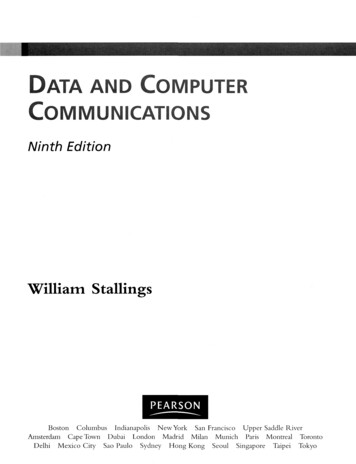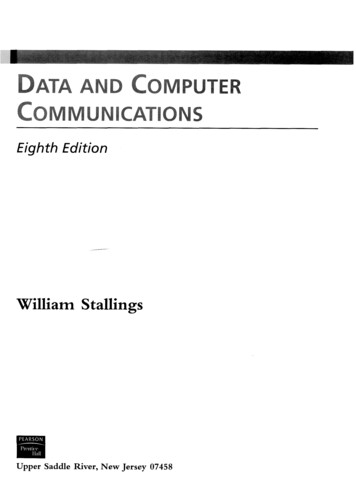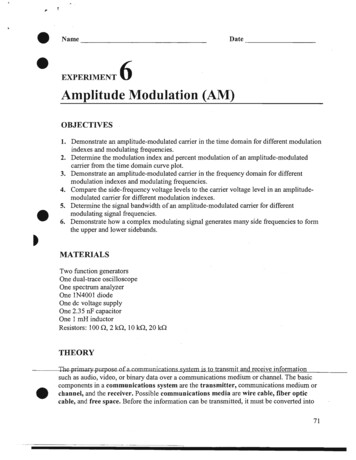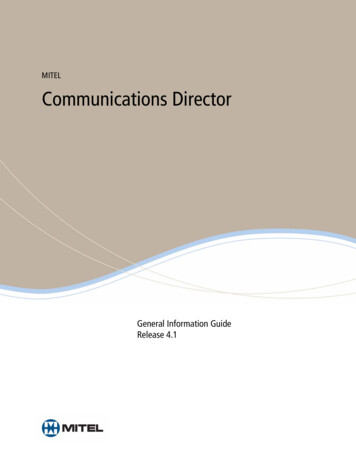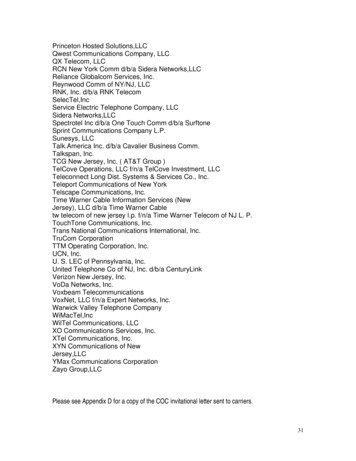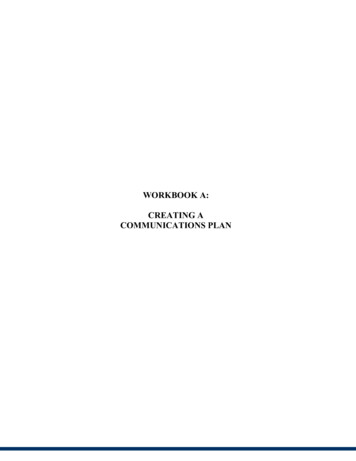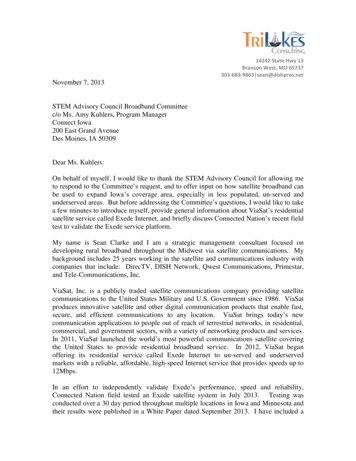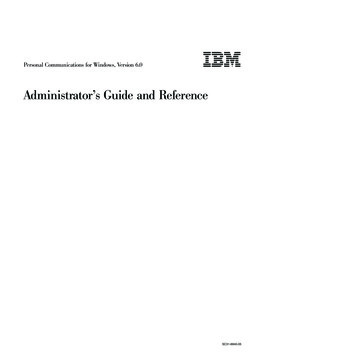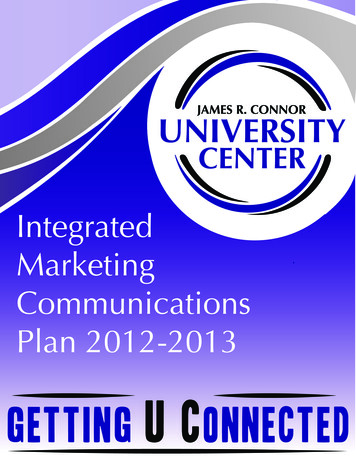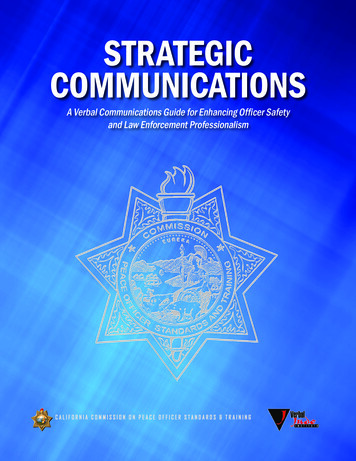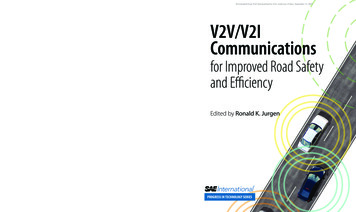
Transcription
Downloaded from SAE International by Eric Anderson, Friday, September 11, 2015Edited by Ronald K. JurgenMillions of automobile accidentsoccur worldwide each year. Some ofthe most serious are rear-end crashes,side crashes within intersections, andcrashes that occur when cars changelanes or drift into a lane. The holy grailof traffic safety is to avoid automobileaccidents altogether.To that end, automakers, governments,and universities are working onsystems that allow vehicles tocommunicate with one another aswell as the surrounding infrastructure(V2V/V2I for short). These systemsshow promise for such functions asintersection assist, left-turn assist, donot-pass warning, advance warningof a vehicle braking ahead, forwardcollision warning, and blind-spot/lanechange warning.This compendium explores thechallenges in developing thesesystems and provides the latestdevelopments in V2V/V2I technology.It begins with a series of overviewnews stories and articles from SAE’smagazines on the progress in thistechnology. This is followed by a seriesof technical papers on V2V/V2I dealingwith the many technical aspects ofdesign of these systems as well asdiscussions of such key issues as theneed for extreme reliability assurancesand traffic congestion overloads onthe systems.This book has been specially preparedfor engineers at automakers andelectronic component suppliers;software engineers; computer systemsanalysts and architects; academicsand researchers within the electronics,computing, and automotiveindustries; legislators, managersand other decision-makers in thegovernment highway sector; trafficsafety professionals; and insuranceand legal practitioners.About the editorAfter graduating from RensselaerPolytechnic Institute with a B.E.E.,Ronald K. Jurgen held various technicalmagazine editorial staff positions,including 30 years with IEEE Spectrum.Now retired, he is the editor of theAutomotive Electronics Handbookand the Digital Consumer ElectronicsHandbook, and assistant editor ofthe Electronics Engineers’ Handbook,Fourth Edition. He is also the editorof more than a dozen SAE books onautomotive electronics.V2V/V2I Communicationsfor Improved Road Safety and Efficiencyfor Improved Road Safety and EfficiencyV2V/V2I CommunicationsV2V/V2ICommunicationsfor Improved Road Safetyand EfficiencyEdited by Ronald K. JurgenJurgenPT-154PROGRESS IN TECHNOLOGY SERIESPROGRESS IN TECHNOLOGY SERIES
Downloaded from SAE International by Eric Anderson, Friday, September 11, 2015V2V/V2I Communicationsfor Improved Road Safetyand Efficiency
Downloaded from SAE International by Eric Anderson, Friday, September 11, 2015Other SAE books of interest:Automotive E/E ReliabilityBy John Day(Product Code: T-126)Automotive Software EngineeringBy Joerg Schaeuffele and Thomas Zurawka(Product Code: R-361)Vehicle Multiplex CommunicationBy Christopher A. Lupini(Product Code: R-340)For more information or to order a book, contact SAE International at400 Commonwealth Drive, Warrendale, PA 15096-0001, USAphone 877-606-7323 (U.S. and Canada) or 724-776-4970 (outside U.S. and Canada);fax 724-776-0790; e-mail CustomerService@sae.org; website http://books.sae.org.
Downloaded from SAE International by Eric Anderson, Friday, September 11, 2015V2V/V2I Communicationsfor Improved Road Safetyand EfficiencyEdited by Ronald K. JurgenWarrendale, Pennsylvania, USACopyright 2012 SAE International.eISBN: 978-0-7680-7805-3
Downloaded from SAE International by Eric Anderson, Friday, September 11, 2015400 Commonwealth DriveWarrendale, PA 15096-0001 USAE-mail: CustomerService@sae.orgPhone: 877-606-7323 (inside USA and Canada)724-776-4970 (outside USA)Fax:724-776-0790Copyright 2012 SAE International. All rights reserved.No part of this publication may be reproduced, stored in a retrieval system, distributed, or transmitted,in any form or by any means without the prior written permission of SAE. For permission and licensingrequests, contact SAE Permissions, 400 Commonwealth Drive, Warrendale, PA 15096-0001 USA; e-mail:copyright@sae.org; phone: 724-772-4028; fax: 724-772-9765.ISBN 978-0-7680-7725-4Library of Congress Catalog Number 2012939984SAE Order Number PT-154DOI 10.4271/PT-154Information contained in this work has been obtained by SAE International from sources believed to bereliable. However, neither SAE International nor its authors guarantee the accuracy or completeness ofany information published herein and neither SAE International nor its authors shall be responsible forany errors, omissions, or damages arising out of use of this information. This work is published with theunderstanding that SAE International and its authors are supplying information, but are not attemptingto render engineering or other professional services. If such services are required, the assistance of anappropriate professional should be sought.To purchase bulk quantities, please contact:SAE Customer ServiceE-mail: CustomerService@sae.orgPhone: 877-606-7323 (inside USA and Canada)724-776-4970 (outside USA)Fax: 724-776-0790Visit the SAE International Bookstore at http://books.sae.org
Downloaded from SAE International by Eric Anderson, Friday, September 11, 2015DedicationThis book is dedicated to my friend Richard Keaton.
Downloaded from SAE International by Eric Anderson, Friday, September 11, 2015
Downloaded from SAE International by Eric Anderson, Friday, September 11, 2015Table of ContentsIntroductionNew Driver Accident Avoidance Aids Are on the Way . . . . . . . . . . .Ronald K. Jurgen, Editor3OverviewsOn the Cusp of Connected Cars . . . . . . . . . . . . . . . . . . . .Steven Ashley7BMW Demonstrates Left-Turn Drivers’ Aid . . . . . . . . . . . . . . .Steven Ashley11Safer Cars Talk to Each Other . . . . . . . . . . . . . . . . . . . .Steven Ashley13V2V, GPS Integration Could Improve Safety . . . . . . . . . . . . . . . 15Terry CostlowDebating IntelliDrive’s Future . . . . . . . . . . . . . . . . . . . . . 17Terry CostlowV2V and V2I Technical PapersAn Autonomous and Car-Following Systemvia DSRC Communication (2012-01-0741) . . . . . . . . . . . . . . . . 21Chan Wei Hsu, Ming Kuan KO, Min Huai shih, and Shih Chieh HuangDSRC Performance Comparison with and without AntennaDiversity Using Different Transmission Power (2012-01-0491) . . . . . . .Sue Bai and Radovan Miucic31Reliability and Safety/Integrity Analysis forVehicle-to-Vehicle Wireless Communication (2011-01-1045) . . . . . . . . 43Arkadeb Ghosal, Fan Bai, Rami Debouk, and Haibo ZengMulti-Sensor System for Vehicle Positioning inDense Urban Areas (2011-01-1035) . . . . . . . . . . . . . . . . . . . 53Zeljko Popovic, Andrey Soloviev, and Yutaka MochizukiVehicle Safety Communications – Applications: MultipleOn-Board Equipment Testing (2011-01-0586) . . . . . . . . . . . . . . Farid Ahmed-Zaid, Hariharan Krishnan, Michael Maile, Lorenzo Caminiti,Sue Bai, Joseph Stinnett, Steve VanSickle, and Drew Cunningham79Understanding Driver Perceptions of a Vehicle to Vehicle (V2V)Communication System Using a Test Track Demonstration (2011-01-0577) . . 95Christopher Edwards, Jon Hankey, Raymond Kiefer, Donald Grimm, and Nina Leaskvii
Downloaded from SAE International by Eric Anderson, Friday, September 11, 2015Vehicle Safety Communications – Applications:System Design & Objective Testing Results (2011-01-0575) . . . . . . . . 113 Farid Ahmed-Zaid, Hariharan Krishnan, Michael Maile,Lorenzo Caminiti, Sue Bai, and Steve VanSickleVehicular Networks for Collision Avoidanceat Intersections (2011-01-0573) . . . . . . . . . . . . . . . . . . . . 131Seyed Reza Azimi, Gaurav Bhati, Ragunathan (Raj) Rajkumar, and Priyantha MudaligeIntegrating In-Vehicle Safety with Dedicated Short RangeCommunications for Intersection Collision Avoidance (2010-01-0747) . . .Craig Robinson and Luca Delgrossi143Intelligent Vehicle Technologies that Improve Safety, Congestion,and Efficiency: Overview and Public Policy Role (2009-01-0168) . . . . . . 153Eric C. SauckPrioritized CSMA Protocol for Roadside-to-Vehicle andVehicle-to-Vehicle Communication Systems (2009-01-0165) . . . . . . . . 163Jun Kosai, Shugo Kato, Toshiya Saito, Kazuoki Matsugatani, and Hideaki NanbaCommunication in Future Vehicle Cooperative Safety Systems:5.9 GHz DSRC Non-Line-of-Sight Field Testing (2009-01-0163) . . . . . .Radovan Miucic and Tom Schaffnit169About the EditorRonald K. Jurgen . . . . . . . . . . . . . . . . . . . . . . . . .viii175
Downloaded from SAE International by Eric Anderson, Friday, September 11, 2015Introduction
Downloaded from SAE International by Eric Anderson, Friday, September 11, 2015
Downloaded from SAE International by Eric Anderson, Friday, September 11, 2015IntroductionNew Driver Accident Avoidance Aids Are on the WayThe annual automobile accident statistics in the United States are sobering: 1.6million rear-end crashes, 634,000 side crashes that occur at intersections, and431,000 crashes caused by cars changing lanes or drifting in a lane [1]. Thesenumbers are expected to decrease considerably in the future when new vehicle-tovehicle (V2V) and vehicle-to infrastructure (V2I) systems become available. Suchsystems are under development worldwide by major automakers, government, anduniversities. They show promise for such functions as intersection assist, left-turnassist, do-not-pass warning, advance warning of a vehicle braking ahead, forwardcollision warning, and blind-spot/lane-change warning [1].This book opens with a series of overview news stories and articles from SAEInternational publications on the progress in this work. This is followed by a series ofpapers on V2V and V2I dealing with the many technical aspects of design of thesesystems as well as discussions of such key issues as the need for extreme reliabilityassurances and traffic congestion overloads on the systems. The following topicsoutline the key challenges and conclusions cited in some of the articles and papersin this book.Traffic congestion will be a challenge if, for example, every vehicle in a traffic jamreported in simultaneously, potentially overloading the network. The German autoindustry and road ministries are conducting a large-scale test of the technologyin 2012 to show that V2V and V2I technologies can operate with “bulletproof”reliability.The effectiveness of using various configurations of antennas and receivers instudying a four-way blind intersection concluded that more representative regionssuch as urban areas needed to be tested and examined. Buildings surroundingan intersection can influence the reception in the side streets. Conversely, lackof buildings in certain directions of the intersection can lead to missing reflectionsurfaces, resulting in considerably less signal power getting into the crossing street.High transmission power can cause radio interference as well.With V2V technology, vehicles can communicate and exchange information usingGlobal Positioning System capability and technology similar to Wi-Fi. If a V2Vequipped vehicle brakes suddenly, this event can be relayed back to a following V2Vvehicle, which can then trigger an alert such as a flashing display or beeping warningto the following driver.3
Downloaded from SAE International by Eric Anderson, Friday, September 11, 2015Since future cooperative vehicle safety applications are expected to be mainlycommunication-based, a significant challenge is in combining and processingenormous amounts of information from the host, surrounding vehicles, andinfrastructure in real-time fashion. Dedicated Short Range Communication (DSRC)is a promising protocol of choice for vehicle safety applications.Features exploiting V2V and V2I communications are still in the early stages ofresearch and development, but growing attention to system-wide infrastructurewill lead to the popularity of such features in the future. This will require originalequipment manufacturer collaboration on interface and protocol standardization andgovernment-supported road/wireless infrastructure.References1. “Stopping Crashes with Smarter Cars,” Consumer Reports, April 2012, pp. 20–23.4
Downloaded from SAE International by Eric Anderson, Friday, September 11, 2015Overviews
Downloaded from SAE International by Eric Anderson, Friday, September 11, 2015
Downloaded from SAE International by Eric Anderson, Friday, September 11, 2015SAE International feature article reprinted from “Electonics Connectivity”, Volume 1, Number 1On the cusp ofconnected carsAn auto consortium is set to put thewireless V2X safety network to the testwith 120 cars in the Frankfurt region.by Steven AshleyConnected-car technology, if done right, would be safe, smart,and affordable. Vehicle-to-vehicle (V2V) and vehicle-to-infrastructure (V2I) communications can alert drivers—and eachother—of unseen road hazards and traffic jams. But before carscan be linked in wireless networks, engineers must show that thecollective V2X technologies operate with bulletproof reliability.After all, fully verified safety is the only way to earn motorists’trust.One significant remaining challenge to V2X technology, forexample, is traffic congestion. What if every vehicle in a jamreported in simultaneously? Would the flood of signals overloadthe network? The German auto industry and road ministries areplanning to find out during the coming spring in a large-scaletest of the technology. Evaluation will take place amid the realroad traffic of the some 5 million plus inhabitants of theFrankfurt-Rhine-Main area of the state of Hesse, the country’ssecond largest metropolitan area.The simTD project (Safe and Intelligent Mobility Field TestGermany) results from collaboration among 18 project partnersincluding major German automakers; suppliers Bosch and Continental; German Telekom; several research institutions and universities; as well as three government ministries.A 120-vehicle test fleet will begin six or seven months of fieldtrials in the spring, said Christian Weiss, the project coordinatorand Manager of Cooperative Systems for the Research and Advanced Development department at Daimler AG. Right nowseveral passenger car models—Audi A4, BMW X1, MercedesA car equipped with V2X wireless communications wouldautomaticallyvehiclescommunicationsif it should becomedisabled.A car equippedalertwithnearbyV2X wirelesswouldautomatically alert nearby vehicles if it should become disabled.C-Class, Ford S-max, Opel Insignia, and Volkswagen Passat—are being fitted to communicate wirelessly with each other andwith sensors in road beds and infrastructure via short-rangeV2X links.The test zone includes hundreds of ITS roadside stationsinstalled by the Hessian traffic center (VZH) and the IntegratedTraffic Management Center Frankfurt (IGLZ) that will enablesimTD test fleet vehicles to exchange data with traffic lights,road signs, and traffic control centers.Next step in auto safety“We are convinced that car-to-X communication represents animportant step on the way to accident-free driving,” Weiss noted. European research generally coincides with a NHTSA (National Highway Traffic Safety Administration) report that in theU.S. four-fifths of vehicle-on-vehicle accidents involving unimpaired drivers could possibly be prevented if vehicles just talkedto one another.Instrument panel displays under test by thesimTDprojectin Germanywill warnInstrumentpaneldisplays undertestdriversby the ofoncomingemergencyvehiclesand theirlanes.simTD projectin Germanywill warndriversofoncoming emergency vehicles and their lanes.7
Downloaded from SAE International by Eric Anderson, Friday, September 11, 2015SAE International feature article reprinted from “Electonics Connectivity”, Volume 1, Number 1And then there is the opportunity to piggy-back all kindsof other local services onto theexisting network, he noted.Concierge-level mobile services,such as parking space reservations in garages, might soonfollow initial installation, forinstance.Short-rangewirelessWhatever their name, V2V,V2I, V2X, or Car2X networksare based on heartbeat-like vehicle-status signals that transferdata over short ranges betweentransponders on vehicles andinfrastructure. The simTD’sITS G5 wireless technology,which is tailored to automotiveapplications, is based on thefamiliar WLAN standard. Thehybrid system meshes the workings of the specially developedThe simTD field test near Frankfurt, Germany, will evaluate rapid local data transfer amongwireless vehicle communicationvehicles and roadway infrastructure.standard 802.11p and UMTSmobile phone technology as“Foremost for us is the safety benefit,” he explained. V2Xwell as ad hoc networking. Thisprovides the basis for all kinds of warnings of dangerous roadapproach was chosen as the most promising because of its poconditions, traffic jams, construction sites and obstacles, andtential for favorable economies of scale, he said.weather dangers. Crucially it can inform drivers early enough toFor most applications, the messages are short, but they haveallow them to adapt, to change their behaviors, to avoid hazto be delivered very rapidly in the tens of microseconds range.ards. The simTD system is to alert drivers of approaching emerThe signals only need to travel a maximum of 500 m (1640 ft).gency vehicles, display to drivers the right lane to take for theFor longer distances, the system uses multihopping technology.next turn, or advise on the optimum speed to catch a wave ofThe wireless message either jumps to a roadside unit, whichgreen lights.passes it on to following and oncoming vehicles. These then“It’s the only sensor that can let you know that there is a hardpass useful messages to others that they meet.braking vehicle right in front of that big truck that’s just ahead,”Weiss said. Though some radars try to pass under vehicles, theydon’t have the same potential, he said: “No other sensor canreliably warn you of what’s going on just ahead of a truck.”Enhanced traffic managementTraffic efficiency should improve as vehicles transmit information on traffic conditions to a control station, which can thenpredict and manage traffic developments, Weiss continued.“V2X technology would allow operators to get a current viewof the state of the traffic.”Today, magnetic induction loops buried in the roadway oroverhead video cameras can count traffic flow at hot spots, butthey are expensive and few. Operators, he explained, have toguess what’s happening in between sensors.“V2X provides an accurate view of what’s happening on theroad network, which allows you to adapt your traffic management strategy to improve capacity utilization, so as to avoidhaving to build new roads, which is a huge overall challenge,” hesaid. Managers might alter the speeds on variable traffic signs toboost safety or traffic flow.8A car fitted with V2X wireless communications will receive earlywarnings of nearby V2X vehicles that become disabled.
Downloaded from SAE International by Eric Anderson, Friday, September 11, 2015SAE International feature article reprinted from “Electonics Connectivity”, Volume 1, Number 1Weiss said that he expected to startthe “pre-experiments” to tune the trial’s evaluation system as soon as theinstrumented fleet expands. NEC Laboratories Europe recently deliveredthe key components of the V2X network software to the simTD partnersthat enables real-time disseminationof data for traffic safety and trafficefficiency as well as infotainmentapplications.Real-world testsSpecialists from the Technical University of Munich are managing the simTD field test and will evaluate theprodigious amounts of data it shouldgenerate. Teamed with researchersfrom Wurzburg University, they aresimulating the impact the introduction of the technology would have ontraffic if the proportion of cars thatwere equipped grew enough.A car with V2X can detect icy surface patches using ABS and stability control sensors and“We have a huge test region, asthen warn nearby vehicles of the hazard.large as any yet tested, that includesall varieties of infrastructure, all major road types—an airport, a tradefair, high-traffic areas,” Weiss said. Analysts will determine howdrivers adapt to the technology and establish how successful it ison highway, rural, and urban roads.“We need to test to [know] what happens if you have a fourlane highway with hundreds of vehicles in traffic transmitting atthe same time,” said the simTD project coordinator. “The communications must be ensured, even under high load. Scalabilityis the key,” he emphasized, pointing out the costly investment ininfrastructure and vehicle technology such a nationwide effortwill require. “Plus we don’t want to have to update it every minute.”The 92 million ( 71 million) project is backed by public andprivate funding, including support from Germany’s FederalMinistry of Economics and Technology, the Federal Ministry ofEducation and Research, and the Federal Ministry of Transport,Building, and Urban Development.9
Downloaded from SAE International by Eric Anderson, Friday, September 11, 2015
Downloaded from SAE International by Eric Anderson, Friday, September 11, 2015SAE International feature article reprinted from July 5, 2011 Automotive Engineering International - Online, Volume 1, Number 3BMW demonstratesleft-turn drivers’ aidtion system establishes the car’s position within a meter andthen matches that point with known intersections on its digitalmap, while a camera-based image-recognition system reads theroad markers that indicate the presence of a left-turn lane.When the driver engages the car’s turn signal, the systemtriggers three front-mounted laser scanners that map the areaforward out to a range up to 325 ft (100 m). The left-turn assistant uses that data to identify oncoming cars, trucks, and motorcycles. If the sensors detect vehicles approaching from theopposite direction but the car continues into the intersection,the system sounds a warning alarm and presents hazard symbols on the instrument panel and head-up displays, while immediately applying automated braking to prevent a collision.This autonomous intervention deliberately occurs with noprior warning, the researchers said, because an instant responseis vital to prevent an accident in these circumstances. Braking isinstituted only up to speeds of 6 mph (10 km/h), which leavesdrivers free to cross the traffic stream at high speed withoutelectronic controls if they so choose.As soon as the driver touches the brakes, however, the systemhalts any automatic braking input, releasing the car so normaldriving can continue. To maximize safety the driver can alwaysoverride the left-turn assistant. If the driver needs, for example,to guide the car to the roadside to clear the way for an emergency vehicle, he or she can do so at any time merely by hittingthe gas pedal.Depending on the actions of the drivers piloting the oncomingcars, turning left at a busy intersection with no left-turn trafficsignal can be a dangerous exercise. Should the approaching traffic include a motorcycle, the potential hazards can easily rise asthe small vehicle can be hidden by road features or remain “unseen” by the turning driver because of inherent weaknesses inhuman perception.Although they vary according to country and region, trafficstatistics indicate that from 30% to 60% of all injury-causingauto accidents and up to one-third of all vehicular fatalities occur at road junctions. Whatever the case, if such a collision doesoccur, the driver making the turn is almost always held at fault.Engineers at BMW Group Research and Technology in Munich recently demonstrated a left-turn assistant autonomousdriver’s safety aid to help overcome the difficulties motoristsencounter when performing this common maneuver. The system, which the researchers are evaluating in a 5 Series sedan, isintended to remove much of the peril of making turns intocomplex intersections by addressing both the visibility issueswith sensors and the sometimes-tricky decisions regardingwhether to proceed with automated braking in the hope of improving safety.“We’ve developed an assistance system that helps driverswhen they turn to the left by warning them of unseen, oncoming traffic,” said Project Manager Arne Purschwitz. “If necesIf the left-turn assistant is augmented with V2V communicasary, it can prevent collisions by automatically applying thetions, which enables cars to “know” where other vehicles aroundbrakes.”them are located, greater safety will result, according to comThe novel technology is being pursued as part of the Europany spokespersons. The BMW 5 Series test sedan is fitted withpean Union-funded Intersafe 2 initiative, which aims to developa V2V unit, which boosts the range of its vehicle-recognitionand demonstrate a cooperative intersection safety system thatfunction to 820 ft (250 m). It also allows the safety system touses sensor fusion data and vehicle-to-vehicle (V2V) wirelessdetect the presence of unseen vehicles that are equipped withcommunications to reduce accidents at road junctions. IntersafeV2V. This capability can be helpful, for instance, when a vehicle2 is a 6.5-million, cost-sharedR&D program that is beingconducted by a consortium ofBMW’s prototype left-turn assistant,11 European car makers, supespecially if accompanied by V2V wirelesspliers, and research institutescommunications, could make maneuvers atincluding BMW, NEC Europeintersections much safer.Network Laboratories, SwarcoTraffic Systems, Volvo Technology, and Volkswagen.V2V enhances benefitLeft-turnoversightThe BMW system activates automatically as soon as the car’ssensors determine that the vehicle is entering a left-turn laneand it registers the driver’s intention to turn left. Recognitionof the lane location is accomplished in two ways, accordingto company researchers. TheGPS sensor in the car’s naviga-11
Downloaded from SAE International by Eric Anderson, Friday, September 11, 2015SAE International feature article reprinted from July 5, 2011 Automotive Engineering International - Online, Volume 1, Number 3follows a line of cars through a left turn, in which case its sensors would probably be screened by the preceding cars.BMW engineers also recently conducted another test scenario that highlighted the benefits of this combined function. Inthis case, the research car approached a BMW R 1200 GS motorcycle fitted with a V2V unit. As before, the data provided bythe camera-based image-recognition system and laser scannersenabled the left-turn assistant to register the lane markings, theleft-turn arrow, and the distance to the center line and stoplines. When the turning driver engaged the car’s turn-signal indicator, the system activated.“The car and the motorcycle communicated with one another via the car-to-x [V2V] interfaces as the motorcycle approached,” explained Udo Rietschel, a development engineer onthe project. “The car and motorcycle exchanged information onthe type of vehicle, its position and speed, as well as dynamicdata such as its steering angle and whether the indicators wereactivated.” The motorcycle’s safety system then employed thisinformation to determine that the car driver planned to turn leftand move in front of it. An algorithm then calculated the vehicles’ trajectories and decided if a collision was likely.In critical situations, the motorcycle would take measures towarn the car driver by taking steps to raise its visibility—by intensifying the brightness of the cycle’s headlights as well as other lights on its sides and mirrors. If its safety system calculatesan acute risk of collision, the motorcycle’s horn would alsosound. Should the car continue entering the intersection, theleft-turn assistant would brake the car automatically while activating the appropriate driver alerts and warnings.BMW’s left-turn assistant system, which is still at the developmental stage, was recently demonstrated publicly at a closedoff road junction in Wolfsburg, Germany. If the engineers canprove the viability of the technology, the company could potentially introduce it into production vehicles by 2016.Steven Ashley12
Downloaded from SAE International by Eric Anderson, Friday, September 11, 2015Automotive Engineering International Online, http://www.sae.org/mags/aei/9385, March 14, 2011Safer cars talkto each otherImagine that you are driving at speed behind a big truck. Unknown to you, a car precedes the truck. Suddenly the driver ofthe lead car hits the brakes hard. Whether you rear-end thetruck depends on three things: your speed, the distance to thetruck, and how fast you can react to the illumination of itsbrake lights. One thing that has little to do with your outcome iswhether your car has collision-avoidance radar or not. That’sbecause, just like your eye, radar can only sense objects that itcan see.Say, on the other hand, that 10 times a second each of threevehicles is broadcasting a safety status report via short-rangeWi-Fi. Suddenly the lead driver slams the brakes. This time thelead car’s emergency stop signal and GPS location is transmitted instantly to your car’s own digital safety monitor, which rapidly calculates that a collision is imminent. The monitor immediately triggers an unmistakable stop sign—a strip of bright redLEDs on your dashboard. Your chances of missing the truckhave improved considerably.Beyond sudden stops, the new technology could alert driverswhen two cars are on a collision course at a blind intersection orwhen a nearby driver changes lanes without looking or losescontrol. This cooperative wireless link could also warn motorists of less critical issues such as an imminent yellow light ortraffic congestion or road conditions.And not only can V2V help save drivers, it can do so a
Automotive Electronics Handbook and the Digital Consumer Electronics Handbook, and assistant editor of the Electronics Engineers’ Handbook, Fourth Edition. He is also the editor of more than a dozen SAE books on automotive electronics. Edited by Ronald K. Jurgen V2V/V2I Communications for

